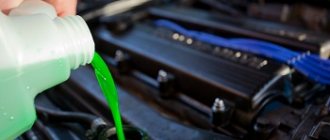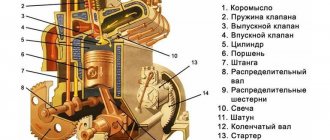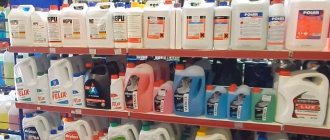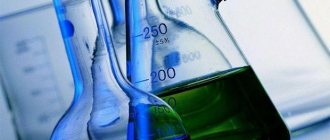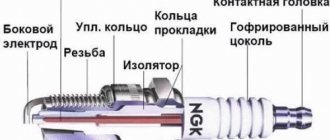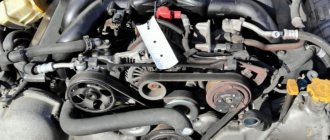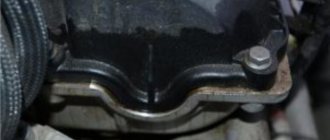Today, the market for technological automotive fluids offers a very wide range of antifreezes. Domestic and foreign manufacturers offer green, red, blue and blue antifreeze. And these are the most popular colors, but you can also buy yellow, pink and purple cooling compound. Such a wide selection can puzzle even the most experienced motorist. Therefore, during the selection process the following questions often arise:
- How do antifreeze differ in color?
- Which one is better to put in my brand of car?
- Does color differentiation make sense?
- Is it possible to mix antifreeze of different colors?
- How does color affect temperature limits?
So that every motorist can get rid of doubts and get answers to these questions, we have created this material. Read it to the end, and the process of choosing car antifreeze will no longer be confusing. We will begin by studying the theoretical minimum necessary for a deep understanding of the topic.
Antifreeze is an almost colorless and slightly viscous liquid designed to cool engine components. Depending on the chemical composition, coolants are divided into the following categories.
Silicate
— the compositions form a protective micron film on all contact surfaces. This operating mechanism cannot ensure high heat transfer efficiency, which reduces the efficiency of the vehicle’s cooling system. Silicate coolants are usually colored blue or green, as well as similar “cold” shades.
Carboxylate
— these antifreezes form a protective film exclusively in areas susceptible to corrosion processes. Nothing accumulates on “clean” surfaces, which makes heat extraction more efficient. Carboxylate liquids have a longer service life and the absence of sediment. Such antifreezes are usually painted in red, pink, yellow and other “warm” colors.
What determines the color of antifreeze
Not many people realize, but the color of the coolant is completely unrelated to its chemical composition and performance properties. Moreover, international standards do not contain strict regulations regarding the color of technical fluids. In fact, in production, ready-to-use antifreeze has an almost transparent appearance. And only at the last stage is it painted.
Antifreeze red, green and blue - what's the difference?
The difference between red, green and blue antifreeze affects its composition, and you should not mix them. Let's look at everything in more detail. All drivers are well aware that the engine is saved from overheating by antifreeze, which can boil at a temperature of more than 100 degrees and freezes at -40 degrees. Not so long ago in our country there was one type of coolant - Antifreeze. This is a blue liquid. Currently, green and red liquids have appeared and are used. Therefore, car owners have a question: is there a difference between them?
Why is antifreeze colored?
The bright color of the composition performs the following functions:
- Visual warning that the container contains a liquid hazardous to health. All antifreezes are approximately 90% ethylene glycol, a very toxic and dangerous substance. Therefore, color coding is an important element of attracting attention.
- Thanks to the bright color of the liquid, it is possible to quickly determine the location of the leak. In addition, if leakage is observed, you can quickly eliminate the cooling system if the shade of the substance is not bright.
- Antifreeze color is a reliable indicator of remaining life. If, upon visual inspection, it is clear that the liquid has darkened, become cloudy, or become transparent, then this is a sure sign that the time has come to replace it.
Which color is better
Having become familiar with the difference between different colors of antifreeze, most car enthusiasts are trying to understand what color should be poured into the cooling system? A good antifreeze will always be the one recommended by the manufacturer.
Car manufacturers often test the antifreeze composition, and when using the recommended composition, there is a guarantee that all parts in the cooling system are working properly, without the risk of rust.
When using an engine cooling fluid of a different composition, even an expensive one, good results are not always obtained on a particular engine. In this case, the color of the liquid does not matter.
Blue
Initially, the Soviet coolant, widely known as TOSOL, was painted this color. Now liquids from different manufacturers have a blue or blue tint. They are united by a class: G11 or silicate antifreeze. They contain ethylene glycol, distilled water and various additives that prevent the liquid from corroding the cooling system pipes. Most often, silicates, phosphates, borates and other substances with a similar spectrum of action are used as additives. The advantage of blue antifreeze is that the additives form a thin film on the cooling system and protect it from wear. But a significant drawback of this action is that the overall heat transfer of the car deteriorates. The average lifespan of blue coolant is 2 years or less.
Antifreeze - Blue antifreeze
The composition contains ethylene glycol + water. There is a red version, which differs in its boiling point threshold. Contains traditional additives: silicates, phosphates, borates, nitrites, etc. In other words, 100% chemistry. At the moment, the technology is outdated.
Minuses:
- Requires replacement after a maximum of 2 years, with high mileage every 6-12 months.
- Ethylene glycol is the strongest poison that can kill a person
- Each additive plays its role in the composition.
- Causes scale deposits.
- Forms toxic compounds.
- The boiling point is 110–115 C, there is a high probability of boiling in some foreign cars.
- Aggressive composition, a foreign car with it may not even start.
Pros:
- Cheap and cheerful.
- At -36C the mixture freezes, turning into a kind of jelly.
%rtb-4%
Red
Antifreeze painted in this color is one of the most modern and effective products. It belongs to class G12. It also contains ethylene glycol diluted with water. But substances with a carboxylic acid base are used as additives. This liquid does not create a protective film. It has a lower freezing point and a long service life of up to 4–5 years. However, it has one drawback: red coolant does not prevent corrosion. It contains substances that specifically combat existing lesions in the tubes. But it cannot guarantee protection against the emergence of new areas damaged by corrosion. Red antifreeze may also belong to the hybrid class G12+ or G12++. Such substances usually contain several types of additives, including silicate ones.
What is the difference?
The main difference between Green and Red antifreeze is that Green antifreeze uses inorganic additive technology, while Red antifreeze uses organic acid-based technology. In addition, the main active ingredients in Green antifreeze are silicates and phosphates, while in Red antifreeze the main ingredient is carboxylates.
Antifreeze or coolant is a very important component of the engine cooling system. Without coolants, it would be quite difficult to prevent the engine from freezing or overheating. Choosing the right automotive fluid is critical to the optimal performance of your vehicle's engine. Therefore, it is important to use the correct type of coolant.
Content
- Overview and main differences
- Purpose of engine coolant
- Coolant technology
- Coolant composition
- Mixing Green and Red Antifreeze
- Conclusion
Purpose of engine coolant
There is no difference in using both engine coolant options. Both serve to protect the engine from freezing and overheating, depending on where in the world you live. If you live in warm regions, coolant will help prevent the engine from overheating. Motorists living in colder climates may rely on antifreeze to keep their engines from freezing.
Green antifreeze
In addition to protecting your engine from extreme temperatures, engine coolants also provide protection against corrosion. The cooling system of a car mainly consists of metal parts. They are susceptible to corrosion if only water is used. In addition, engine coolant helps fight the formation of scale or deposits. If scale and deposits allow to accumulate, it can reduce the efficiency of the cooling system and cause faster engine wear. Therefore, you should monitor the coolant level and change it promptly after its service life has expired.
Modern engine coolants also contain anti-foam additives. Preventing foam formation with antifoam additives can help improve efficiency in cooling systems. All this leads to increased engine performance and the prevention of unnecessary wear and tear.
Coolant technology
Coolant manufacturing technology is the main difference between green and red antifreeze. Green antifreeze uses inorganic additive technology, while red antifreeze uses organic acid-based technology.
The inorganic additive technology used in green antifreeze is older. Coolant manufacturers produce this type of antifreeze for car engines built before the year 2000. Many of these cars have copper and steel components in their radiators. Inorganic substances are those that do not contain carbon in their chemical composition. This type of engine coolant contains anti-corrosion additives. They have a service life of about two to three years. After this period, the coolant requires replacement.
Red antifreeze
Red coolant uses organic acid technology and includes chemicals that contain carbon. This is a newer technology, in response to changes in the composition of materials in new car engine cooling systems. Modern cars now use nylon and aluminum instead of steel and copper in their cooling systems. The additives in red antifreeze prevent corrosion while helping to cool the engine.
There is another type of engine coolant, which is an offshoot of OAT (Organic Acid Technology) fluids. This is an OAT hybrid. It combines the cooling efficiency of IAT (Inorganic Acid Technology) fluids with the corrosion resistance of OAT. Coolant created using this technology is usually tinted yellow, pink, red or blue. The service life of these coolants is 4 to 5 years or up to 100,000 km before it needs to be replaced.
Green
Coolants of an emerald or turquoise hue are inherently traditional or, in rare cases, hybrids. They belong to class G11, as they contain silicate additives. The protective film they form is the same as the blue ones. The only difference in this case is the color of the dye used by the manufacturer. But some of the green antifreezes belong to the G12+ class hybrid fluids. They contain both organic and inorganic additives: the additives contain both carboxylic acid and silicates. Such a coolant will have a thinner film layer than a traditional one. Therefore, it is more advanced than simple green antifreezes. The service life of all compositions of this shade is approximately 2 years.
Antifreeze G11
This is an imported product. What color is this antifreeze? It has a green color. The characteristics of this liquid are similar to antifreeze. And in terms of cost, this antifreeze is the cheapest among imported ones. This was used on budget cars of the 90s, as well as on some “Koreans” of the early 2000s. The composition contains ethylene glycol and water. As for additives, there is a set of chemical and organic elements. These are borates, phosphates and carboxylic acid in small quantities. The latter is designed to combat corrosion processes inside the system.
Are there any disadvantages to this liquid? Reviews note a short service life - only three years or 90 thousand kilometers (on par with antifreeze). By this time, antifreeze from this group begins to precipitate. In the expansion tank you can see characteristic green flakes. This indicates that the antifreeze has outlived its useful life.
Sometimes there are G11+ and G11++ products on the market. What are their differences? The difference with regular antifreeze is small. It consists only in the concentration of carboxylic acid. In terms of cost, such products are 10-15 percent more expensive. What color is antifreeze with this marking? The answer is green. Although there are some products that are colored yellow.
Yellow
This color is one of the most difficult to determine the quality of coolant. Various manufacturers use it to color hybrid, lobrid and traditional liquids. Therefore, it can equally well belong to the class G11, G12+ or G12++. Most often, yellow-green liquids are those made using traditional technology. They contain silicate additives. And antifreezes that are orange or a deeper shade of yellow are usually hybrids and contain carboxylic acid. Some manufacturers create antifreezes that meet the requirements of class G13, but paint them bright yellow. This happens because the purple shade in which such a liquid was first released was patented by its manufacturer. Therefore, the color of yellow antifreeze is a false guide: it can confuse even an experienced car enthusiast. In order not to make a mistake, you should carefully read the composition of the liquid and look at the labeling.
Violet
If you see antifreeze of this shade, it is a representative of the G13 class. This is an effective coolant that combines high protective properties and resistance to very low temperatures. Dyes of lilac, lilac, pink and deep violet are used for lobrid liquids. The main difference with other antifreezes: it does not use ethylene glycol, but propylene glycol. This is a fairly gentle substance for the cooling system. Therefore, such liquids are considered safe for humans and cars, as well as more environmentally friendly. They have a long service life, which can reach 5 years. Another antifreeze that may have a purple color is the MULTIFREEZE product, which is unique in its properties. It combines the properties of traditional and carboxylate fluids and is suitable for mixing with any other coolant.
Red antifreeze or G12
Red antifreeze (designated as G12 ) contains mainly organic additives and very few inorganic ones. Thanks largely to this, he:
- Excellent localization of corrosion areas;
- Forms a fairly thick (about 1 micron) film that practically does not crumble;
- Dissipates heat well;
- Serves up to 5 years without replacement.
However, red antifreeze, despite all its obvious and undeniable advantages, also has some disadvantages. Perhaps the main thing is that it only fights existing foci of corrosion, but does not have any preventive effect in this regard. In addition, red antifreeze does not protect aluminum parts well from “corrosion.”
It should be noted that there are such variants as G12+ and G12++. They differ from G12 in an increased number of additives of organic origin.
Is it allowed to mix different antifreezes?
Due to the lack of uniform and mandatory standards, the composition, color and performance characteristics may differ even within the same brand of coolant. Therefore, experts advise making it a rule: mixing different types of antifreeze is extremely undesirable. Moreover, even when switching from one type to another, the system must be flushed with a special cleaning compound. At best, experiments to create your own coolant formula will lead to a decrease in the efficiency of heat removal. In the worst case scenario, the motor will seize, and this is an expensive and complex overhaul.
Antifreezes and standards
There is no single standard for antifreeze and its designation. Each country uses its own. For example, in the USA, the ASTM standard applies for ethylene glycol fluids, and the SAE standard for propylene glycol fluids. Volkswagen focuses on tolerances G11, G12, G12+. In Japan, the designation even indicates the color of the antifreeze. Our country has GOST, but it was developed during the USSR and now no one looks at it.
However, each manufacturer introduces its own standards for the composition, color and designation of antifreeze, so it is sometimes difficult for the average consumer to navigate this mess.
Here you can learn in more detail about the differences between G11, G12, G12+, G12++, G13 and G13+, about the composition of antifreeze, their color and characteristics, and how to check the quality of antifreeze when purchasing. And also about what is better: antifreeze or antifreeze. And in what cases is it permissible to use one or another coolant, is it possible to mix antifreeze with antifreeze or make a “cocktail” from different brands of antifreeze.
What does practice say?
Manufacturers of antifreeze do not agree on the “recipes” of their products among themselves, since mixing is not provided for by technical regulations. Therefore, situations often occur when two different coolants enter into different destructive reactions. For example, the resulting composition may thicken already in the pipeline, which will lead to flushing. Sometimes components of different antifreezes neutralize important qualities of each other. For example, it has been experimentally proven that adding even a small amount of G11 to the bulk of G12 leads to complete neutralization of the carboxylate properties of the additive composition. It turns out that the additive simply spoiled all the coolant.
Useful tips
- Form the habit of buying antifreeze in some excess. You need to carry a reserve with you in case of force majeure situations. This practice will allow you to confidently fill in exactly the coolant that is already in the system, which guarantees the absence of “conflicts”.
- If the trunk is small, then you can make it a rule to carry with you not the entire canister, but the label from it. In order not to lose the “hint”, it can be tied to the filler neck. Today, even in small roadside stores there is always a large selection of antifreeze, so finding an analogue will not be difficult.
- Sometimes you may notice that there is only a small amount of coolant missing from the reservoir. This indicates that some of the water simply boiled away. In such a situation, you can simply add up to 250 ml of distilled water. This simple operation will help restore the optimal ratio of active substances in the composition, and also raise its level.
Let's sum it up
Now we are convinced that the difference in the color of antifreeze is far from the most important and unambiguous criterion. Therefore, when choosing a coolant, you need to pay attention to the following points:
- chemical basis;
- international classification;
- car manufacturer's recommendations;
- indicators of boiling and freezing temperatures.
These are objective factors that will help you accurately make the right choice.
#Antifreeze reviews#Advice from experts
You may also be interested
What antifreezes can be mixed: compatibility table
In some situations, it becomes necessary to combine different cooling compounds. Liquids have to be mixed, for example, when you need to add the missing amount of coolant to the system in case of unexpected breakdowns on the road. To extend the service life of cooling system components, you need to study in advance information about the compatibility of different compositions.
At what temperature does antifreeze freeze?
Antifreeze is designed to resist low and high temperatures, remaining in the same consistency. It should not boil when the engine heats up and harden in cold weather. But for many drivers, despite all the tricks, antifreeze freezes in the cold season. Let's talk to experts about why this is happening?
